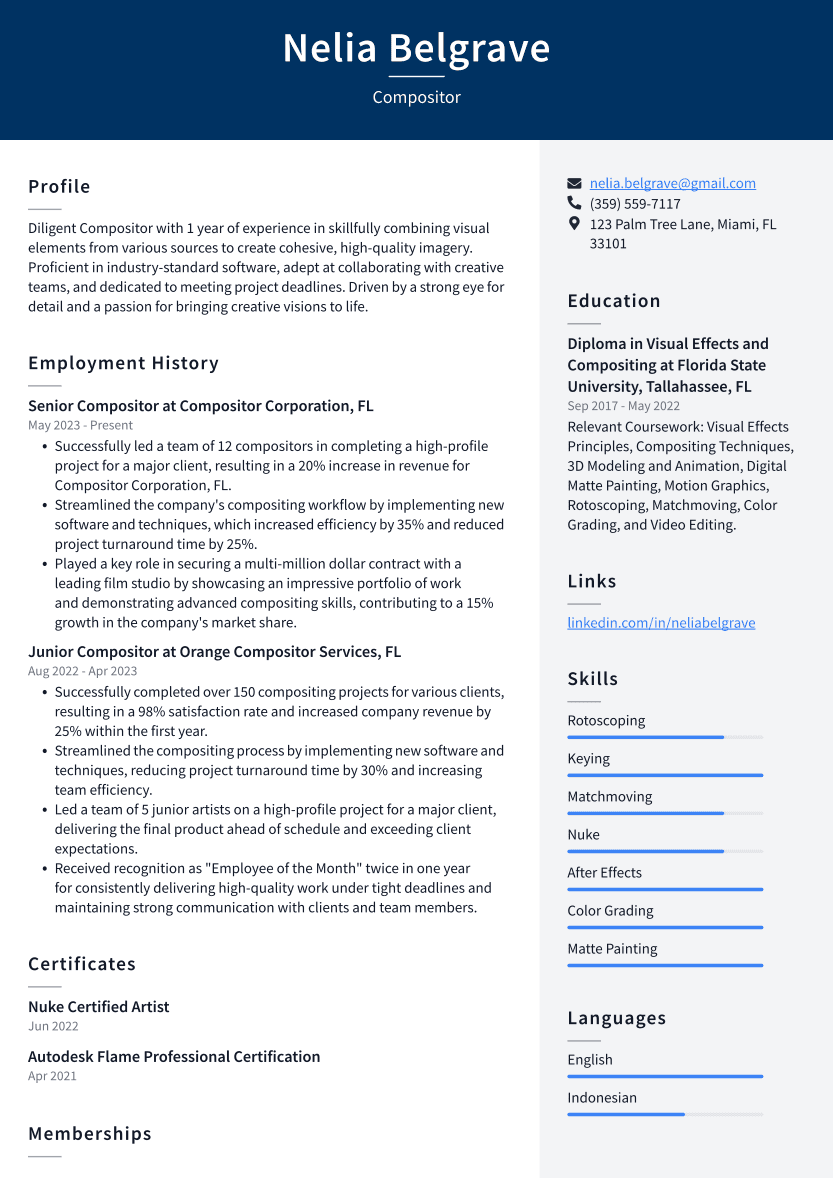Compositor Resume Examples
Writing a great compositor resume is important because it is one of the first things a potential employer will see when they are considering you for a position. It is your opportunity to make a good first impression and sell yourself as the best candidate for the job.
Create your resume
Select from 7 professional resume templates
If you're looking for inspiration when it comes to drafting your own compositor resume, look no further than the samples below. These resumes will help you highlight your experience and qualifications in the most effective way possible, giving you the best chance of landing the compositor job you're after.
Essential Components of a Compositor's Resume
For professionals in the field of digital compositing, a well-structured resume is a critical tool for showcasing their expertise. Compositors are artists who blend visual elements from various sources to create seamless images, often for the entertainment industry. A standout resume for a compositor must highlight technical prowess, artistic sensibility, problem-solving skills, and a solid grasp of compositional techniques.
In the following sections, we'll dissect the essential elements of a compositor's resume, explaining their significance and detailing what to include. Additionally, we'll offer tips to enhance each section's impact.
1. Contact Information
At the top of your resume, your contact information is fundamental. It should be current and include your name, address, phone number, and a professional email address. This section is not just about providing a means of contact but also sets the tone for your professionalism.
2. Professional Summary
The professional summary is the introductory segment of your resume and the first impression you make on employers. It should concisely convey your career goals, core competencies, and the unique value you bring to a compositor role.
An impactful professional summary can be a decisive factor in advancing your application to the next stage.
3. Skills and Proficiencies
This section is a showcase of your technical skills and artistic capabilities. It should enumerate your proficiency with compositing software and tools, as well as your ability to execute complex visual effects. Highlighting these skills is crucial in demonstrating your readiness for the role.
4. Professional Experience
Your work history is a testament to your journey in the industry. Detail your past roles, emphasizing your contributions and accomplishments. Include any relevant freelance or internship experiences, as they enrich your narrative and demonstrate a comprehensive background.
5. Education and Training
Education and training provide context for your technical skills. List your academic credentials and any specialized training, focusing on their relevance to compositing. This information reassures employers of your foundational knowledge and commitment to the craft.
6. Portfolio or Sample Works
A portfolio is the visual proof of your compositing skills. It should feature a variety of work that showcases your versatility and adaptability to different styles. This tangible display of your abilities is often what convinces employers of your potential.
7. References
References serve as a professional endorsement of your skills and work ethic. They are typically contacted later in the hiring process but are an integral part of your resume. Ensure that your references are informed and willing to vouch for you when the time comes.
By carefully crafting each section of your resume, you can present a compelling narrative of your qualifications as a compositor, making it more likely for you to capture the attention of potential employers and land your desired role.
